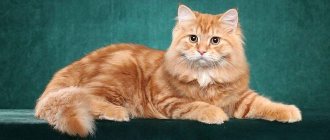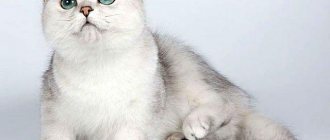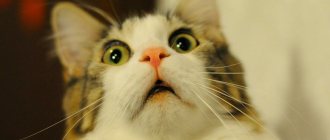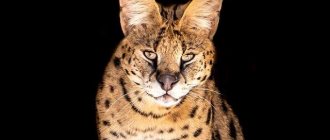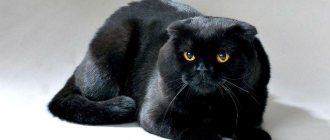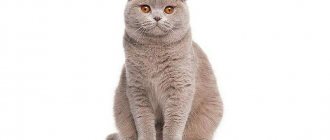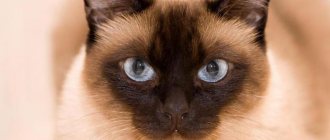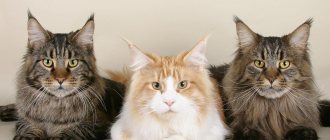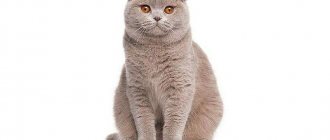The ginger fluffy cat is a classic representative of the cat family. In the natural environment, its pure (without impurities) color behaves capriciously. Red shades of fur appear in offspring only if a number of hereditary conditions are met, but even felinologists do not undertake to predict its appearance in advance.
This color is unusual for the British, but among the Persians, on the contrary, it is not considered a rarity. However, all cat breeds have one thing in common - almost every litter produces babies with a luxurious red coat.
Are there ginger cats that are girls?
Boy and girl cats have different sets of chromosomes:
- the cat has a double X chromosome (XX);
- The chromosome set of a cat is XY.
As for the O gene, it is attached only to the X chromosome, and has two “coloring” alleles: O (red) and o (black). In practice this is expressed like this:
- OO with two XX in girls gives a red color;
- the same chromosomes with the oo alleles create a black tint;
- With a set of Oo, two-colored (tortoiseshell) kittens are born.
Male cats have fewer options because they have only one X chromosome, which can be accompanied by a single allele expression: O (red) or O (black). But nature did not program cats with two-color red and black colors.
In practice, this complex genetic kaleidoscope is expressed in the fact that in a litter there are fewer red cats than males.
Important! Under natural conditions, ginger cats are born approximately 3-4 times more often than female cats. This even causes the unfair judgment that only boys wear bright sunny coats.
Why are cats without tails?
Geneticists explain the origin of cats with short tails by mutation. If we take the Isle of Man hypothesis as a basis, then we need to keep in mind the influence of inbreeding, as well as the passage of the mutated gene from generation to generation.
The nosological group of Manx was divided into rampies (no tail at all), risers (single-vertebral process), stumpies (short tail), longies (regular).
Bobtails can be completely tailless or short-tailed. The English words bob - pompom and tail - give rise to the name for the branch of short-tailed animals under the name bobtail.
Color options
Since a cat has more color options, it means that she also passes them on by inheritance:
- Only the red allele O is passed from mother to male cat;
- Characteristics of two parents are passed on to female kittens (genes O and O).
Other colors and color spots that were present in the animal’s relatives play a role in the formation of coat shades.
- White-red cat. The white gene (W) is dominant over all others, the spotting (S), partial spotting (Sp) allele and the white recessive ww allele also work. The tendency to white spotting is always dominant in relation to solid colors.
- Red tabby cat. The fiery color is never continuous. It definitely shows patterns in the form of stripes or marble spots. In genetics, this effect is called “tabby” and it is responsible for the characteristic pattern on the coat.
- Red marbled cat. We are talking about shading the tabby pattern. In ginger cats it is necessarily present, but in varying degrees of contrast. A heavily shaded tabby looks like a pure color, a slight blurriness leads to a distinct pattern, a moderate shade is associated with marble stains.
- Cat in light red tones. The D gene comes into play. It is responsible for color saturation and colors the hairs a deep and uniform red. But in the dd modification, lightening occurs, then the pigmentation granules in the hair structure are sparse.
- Cat in black, white and red tricolor. The combination occurs only in girls. Cats are deprived of this color due to a single X chromosome, to which only one allele responsible for pigmentation can be attached. The exception is male individuals carrying the chromosomal formula XXY. But they are, as a rule, sterile and do not take part in reproduction. Therefore, the white-red and black color is the privilege of cats.
- Black cat with red spots. A kitten gets tortoiseshell coloring from two parents who carry the genes for black and red hair pigmentation. Most often, girls become carriers of this combination.
Important! A total of nine colors form the main color palette of cats. An ordinary ginger cat must receive the red pigmentation gene from two parents. Otherwise, he will not have a sunny coat color.
Care and nutrition
Persian cat: description of breed and character, how long they live
You need to care for a red and fluffy domestic cat in the same way as a pet of any other color. It is necessary to monitor your pet's diet so that it does not turn into an arrogant fat cat, like the famous cartoon character named Garfield. You will need to take into account the characteristics of the breed and ask the breeders what to feed the Maine Coon or Turkish Van, and also find out in more detail what disease the pet is susceptible to.
Important! According to experts, ginger cats tolerate anesthesia and similar drugs for pain relief less well than others. This fact has not been scientifically proven, but nevertheless it exists.
Every pet needs stable and proper nutrition, healthy sleep in a place specially equipped for it, and regular examinations by a veterinarian.
Many diseases can be prevented by giving your cat vaccinations; in addition to them, you need to monitor the animal’s health. This will help avoid troubles in the future, especially when it comes to young cats and kittens that require special care.
Breeds of red cats
A cat with a red color can be found among both purebred and mongrel pets. "Ryzhik" can also be fluffy or short-haired.
British cat
A short-haired cat with a strong, muscular body and thick, silky fur. The most popular color is smoky blue, solid or tabby. Red shorthair cats of the British breed are rare and there are much fewer girls among them than boys.
In detail - about red British cats.
But among the British, sometimes there are long-haired cats; they look especially interesting in their white and red color. Breeders sought to obtain new shades, and as a result of crossing a British cat with Somali and Persian breeds, luxurious, lush fur was fixed in the genotype.
Siberian cat
Representatives of this breed have long, lush hair (with hypoallergenic properties) and a double undercoat. Siberian fluffy ginger cats with eyes of a rich orange-amber hue are a rarity; many catteries are separately engaged only in their selection.
Even more unique are Siberian ginger cats with a tabby striped pattern and white accents on the shirtfront and paws. There are no such animals in the group of smooth-haired pets.
Maine Coon (Manx coon cat)
A very large cat, its height is 1 meter in length and its weight exceeds 8 kg. Unlike other breeds, which reach their maximum size by the age of 2, Maine Coons grow until they are 3-5 years old.
Possible eye colors
The color of a cat's eyes depends on the amount of melanin in the iris, and the intensity of the color depends on the level of melanocyte activity. Because of this, we may think that one individual with yellow eyes has a brighter look than another. If the eyes are not yellow, but rather orange, then this means that this animal has strong melanocytic activity.
Interesting: in cats there is no correlation between skin color and eye color, so a black cat with yellow eyes is quite possible, as is a red fluffy cat with bright green or blue.
Signs associated with ginger cats
Red cats, just like black ones, are haunted by all sorts of legends.
- It is believed that red pets are always obstinate and overly independent. In fact, there is often a very strong emotional bond between an animal and its owner.
- Picking up a ginger kitten on the street and bringing it into the house means attracting prosperity and good luck. Since the fiery color is no more common among street vagabonds than among their purebred relatives, not everyone will experience such happiness.
- Some people believe that a sunny-colored cat absorbs negative energy and protects a person from negative influences.
They also say that they purr louder than others, cure alcoholism, and predict illness and death. The only true observation is expressed in the popular saying “a cat in the house means happiness in it.”
Signs and superstitions
There are many signs associated with red cats. Many believe that they are capable of bringing good luck and wealth to their owners. There is some truth in this, as some owners of these pets say.
What does it bring to the house?
According to an old belief, anyone who shelters a ginger cat in their home will bring good luck to themselves and their loved ones. But you need to give your pet the largest food bowl; the larger it is, the greater wealth you should expect in the future.
According to another belief, if there is a ginger cat next to a sick person, he will recover much faster. There is some truth in it, because ginger cats really influence the psyche and health of their owners in the most positive way.
Red cat in the house: good or bad
If you place a cat of light red, gray and red or striped color in the house, with or without a spot, the atmosphere in it will certainly improve, and its owners will feel a surge of strength and energy. This will happen because an economical and intelligent red-colored pet will appear in the house, because the appearance of a cat always brings good luck. The animal is able to take on negativity, protect its owners from damage and give them a positive attitude.
Attention! When a ginger cat comes to a house or apartment on its own, this is a favorable sign that should not be ignored. Such an animal is worth adopting, and it will certainly reward its owners.
The sign with a red kitten works in exactly the same way: if you find it on the street, you can expect cash flows, and the one who shelters the baby will become a rich and happy person.
Each ginger cat is unique, and having such a pet in your home is real happiness and pleasure. At the same time, it does not matter whether he is purebred or not, if the animal brings joy and cheers up every day, and the owners reciprocate his feelings.
American Curls
Among the famous breeds of red-colored cats are the American Curls. These cats have a unique generic indicator - ears turned inside out. The first representative was discovered in California on a farm half a century ago. A kitten of original appearance was transferred to the exhibition and registered in the TICA system.
© shutterstock
American Curls have a long frame and a round head shape; the four-legged dog is compactly formed and has a well-built physique. Curls have excellent health, which is typical for the breed.
Cats can wear almost all colors. The cat's fur looks great :
- In brown
- silver,
- white,
- blue
- and, of course, in red color.
This breed of red cats is well suited for keeping by the male half of our society, as it does not require special care. Animals are very attached to the owner, love home fun, and can fulfill some of the owner’s whims, for example, bringing slippers, jumping over barriers.
Persian cats: aristocracy and greatness
The Persian cat always means aristocracy and greatness. The breed is ancient, its roots come from the beginning of the 12th century. A characteristic feature of the breed is a depressed nose, located at the same level as the eyes. Silky fur is the pride of the Persians. Its colors come in different colors, but the most elite ones are gray, lilac, black, red, blue and cream. And the brightest and most in demand today are red Persians with large, intelligent eyes.
Persian cats are very loyal animals; they never leave their owners’ side; they explore the area, following on their owner’s heels. They love communication, finding a common language with all residents of the apartment or house. Persian cats do not like to be alone; they will happily travel with their owner, so as not to be left alone at home. This is a measured and balanced genus of cats.
Turkish Angora
The Turkish Angora is a natural breed that existed in Turkey several hundred years ago. These cats are often depicted in white, although their colors can be black, blue, red, etc.
Turkish Angoras are energetic, assertive, and require stimulating play to maintain a positive emotional state.
Breed overview
Height: 17.8-25.4 cm
Weight: 3.2-6.4 kg
Physical characteristics:
- muscular body;
- long paws;
- thick “fur coat”;
- almond-shaped eyes.
Persian
The color white is often associated with Persian cats, although they come in a variety of colors and patterns. Their long, flowing coat requires careful grooming, which includes daily brushing and removing matted areas.
Persians are sweet and easy-going pets who prefer to be in a calm and predictable environment.
Breed overview
Height: 20.3-25.4 cm
Weight: 3.2-5.4 kg
Physical characteristics:
- long wool;
- short and strong legs;
- Round eyes.
Oriental
Slender and athletic, Orientals can come in a variety of colors, including plain white. These animals are active, talkative, attractive and love attention. Some pets become so accustomed to people that it can be difficult for them to accept being separated from any family members.
Breed overview
Height: 20.3-25.4 cm
Weight: 2.7-5.4 kg
Physical characteristics:
- smooth body;
- angular head shape;
- big ears;
- almond-shaped eyes.
Siamese
Siamese cats, which are called "foreign whites", do not have the usual dark spots on the body of the ears, face, paws and tail. Moreover, all representatives of this breed are born completely white, receiving the traditional color as they grow up.
Siamese love their family members and prefer to be the center of attention. They are overly “talkative” and enjoy using their voice to tell their owner about their needs.
Breed overview
Height: 20.4-25.5 cm
Weight: 3.6-4.5 kg
Physical characteristics:
- smooth body;
- almond-shaped eyes;
- wedge-shaped head.
Red representatives of the Ural Rex
The Ural Rex breed is considered unique, as it was obtained naturally; humans did not participate in its development. An unusual curly-haired cat lived in the Urals, then she was brought to a nursery in Moscow, where breeders began improving the breed.
© shutterstock
Ural rexes are medium-sized. The cat's fur is curled in the form of thick small curls. Often you come across Ural rexes of chocolate, blue, tortoiseshell, and bright red shades. Representatives of this breed like to communicate, they love to sleep in their master's bed, they treat family guests calmly, and they can allow themselves to be petted.
History of tabby cats
Domestic cats inherited striped and spotted colors from their wild ancestors - such camouflage makes predators “invisible” when hunting and hides them from enemies. Many species of wild cats still wear striped coats to this day.
Such patterns on wool are called tabby - in honor of the precious oriental silk with moire patterns, once extremely popular in Europe. All other colors of domestic cats were the result of genetic mutations, and subsequently, selection work.
Tabby color is quite logically called “wild”, but there is no need to fear that its carriers will have a ferocious, predatory disposition. Domestic minke whales are just as docile and affectionate as cats in other “clothes.” Some felinologists and veterinarians claim that tabby cats naturally have stronger immunity and more pronounced instincts.
Striped fur is very popular among both outbred and purebred animals. In each specific case, it looks organic and exclusive: the tabby pattern is always unique, and its owners are bright personalities.
Photo gallery: mustachioed, striped, but very different
Wild patterns are unusually good on long fur. A tabby cat looks menacing, although in fact it may have a peaceful disposition. Even hairless cats - sphinxes - can be striped. Unfortunately, stripes will not make a fat cat look slimmer, even visually.
And on the street there are gorgeous tabby specimens
This cat may be a mongrel, but his life is clearly going on a bright path.
Color point can also be a tabby
Tabby clothes suit a long-eared Oriental. A striped Scottish Fold with curved ears is very cute. This short-legged striped whale is a munchkin, he can sit like a meerkat.
Smoky striped color is definitely exclusive
From reviews of Siberian owners
The happy owners of these luxurious creatures share their joy and talk about their personal experiences with them. Their ability to easily adapt to new conditions is noted, in particular when they take into the house not a small kitten, but an adult. They talk about friendliness and playfulness.
For example, when a Siberian cat gets bored, he can show resourcefulness to involve the owner in the game - find some toy lying around, bring it closer to the owner and move it towards him with his paw, while looking at him affectionately and slyly.
There are also critical remarks about the breed, saying that the pet has long been an adult, but when playing it still does not remove its claws, and all household members walk around wounded, it is vindictive, and if you touch it while passing, it will soon attack from around the corner.
To this we can answer that, most likely, the owners themselves are to blame, they spoiled the baby, allowed him to scratch, and did not have time to look back at how he grew up. Now this is a familiar form of play for him. And, perhaps, it’s not a matter of rancor, it’s just that the cat, when he was hurt, thought that he was being flirted with, and simply supported the game.
And there are also interesting oddities when a Siberian cat is friends with the male half of the family, for example with the owner and his sons, but only tolerates the female half, for example his wife and mother-in-law, for which the owner respects him and considers him a real man.
Caring for bobtail cats
Once every two weeks, short-tailed animals need to be bathed using a special shampoo. Fluffy pets treat water with love rather than hostility. This is especially true for the Kuril Bobtail, which is accustomed to high climate humidity. Their fur doesn’t even get particularly wet – the water just rolls off it.
The coat is combed once a week to accustom the bobtail cat
from early childhood. It is especially important to comb out the fur during the shedding period.
Pets' claws are trimmed at least once a month.
Caring for cats with short tail stumps includes a visit to the veterinarian: it is better to prevent diseases than to treat them.
Keeping breeds without a tail
Bobtail cat breeds have a slightly canine character: they are characterized by a love of active games with the owner or his children. These cats are highly trainable. Keeping tailless breeds is not difficult if you remember that cats are demanding of the owner's attention. There are no other special differences from keeping other cats. The advantage of short-tailed cats is the lack of desire to mark territory - if having other cats, you have to study material on how to get rid of the smell of cat urine, then bobtails and Manxes will not make the owner worry about this.
You can walk on a leash at least every day. Kittens quickly get used to the harness and do not cause any trouble.
Feeding
Felines with a pom-pom tail are susceptible to the quality of food, both natural and industrial. If you want to feed your pet natural food, you can contact your veterinarian for advice: he will help you create a diet that is suitable for your cat during this period of time.
For older purrs, a lifelong menu is drawn up, with the introduction of vitamin complexes 2-3 times a year.
Short-tailed animals are fed twice a day, in the morning and no later than six o’clock in the evening. The norm is considered to be a portion, after eating which the cat calmly moves away from the bowl. If she stays and licks the plate, it means the portion is small.
Tabby cat breeds
In both purebred and street cats, tabby color patterns are formed in the same way - thanks to the ticked coloring of the fur hairs.
Asian tabby
The name of this breed directly indicates both its origin and color. Representatives are only striped.
But a lot of scope opens up for breeders in the direction of variety of patterns and color combinations on cat coats, which looks great on short, densely padded fur.
Photo gallery: striped, marbled and smoky - Asian tabbies
Black marble on silver - elegant and elegant
Smoky tabby - mysterious color
A real cat should be fat and striped - just like this one
Video: Asian tabbies, smart and beautiful
Norwegian Forest Cat
A chic fur coat for a Norwegian forest dog is not a luxury, but a necessity in the northern climate. The thick undercoat, which does not get wet in the snow, warms the cat even in the most severe frosts.
The Norwegian Forest Cat comes from a cold country and has luxurious long hair.
The breed has always been famous for its variety of wild colors, the palette of which is being successfully expanded by breeders. Norwegian tabby kittens are especially highly prized.
Photo gallery: wild colors of the domestic Norwegian
Lilac tabby - elegant exclusive This kitten will grow into a handsome striped giant
White socks add charm to tabby
Dark marble on long thick fur looks blurry and indistinct
For such a fur coat, snow is not scary. Black marble on dark silver is very impressive. Fantasy on the theme of torbi - striped and tortoiseshell
Video: Norwegian Wild Forest Cat
Cymric
The Cymric (Welsh) cat looks like a well-fed rabbit, and its fur is soft, long, and silky. The undercoat is so thick and dense that the awn at the base is raised almost perpendicular to the skin. This type of fur makes contrasting marble stains on a red, gold or silver background, to match which the nose and pads . But the expressive eyes of Cymrics usually have the color of ripe gooseberries.
Cymric received its name in honor of the Celtic tribe that once inhabited the English peninsula of Wales.
The most popular breed colors: red marble and torby - an original combination of tortoiseshell (torty) with elements of tabby, which is found only in cats.
Photo gallery: tabby colors of the Welsh “cat-rabbit”
A ginger cat is always out of competition Blue marble on silver is an elegant outfit for a gentleman
Black mackerel stripes, a gold background and white “socks” are very beautiful
Thorby fur coat is a purely feminine outfit
American Bobtail
The short tail of the American Bobtail is a consequence of a natural mutation. At first, cats of this breed were long-haired, but then bobtails with short hair appeared.
Representatives of the bobtail breed are distinguished by their beauty and excellent health.
Among the variety of American Bobtail colors, tabby variants are one of the most popular. The colors of the eyes, nose and fingertips should match the tones of the striped coat.
Photo gallery: bobtail colors - from light silver to dark gold
Blue spotted on silver - this color will not leave anyone indifferent
Black marble on gold looks bright
Specks and stripes are charming in any version
Red marble - a color for a real macho
Hypnotic stains on silver enchant
Video: energetic hunter with short tail
Pixie bob
The Short-Tailed Pixie Bob is the only breed whose standard welcomes polydactylism. The breed's thick coat can be either short or long.
Despite their wild appearance, these animals are kind and playful.
The cat is very similar to a lynx, and it has a corresponding color - usually spotted, less often - mackerel: a dark pattern on a contrasting background, from sand to gray. The pads are usually black, and the nose is also outlined in black.
Photo gallery: “lynx” pixie-bob clothes
Traditional “clothes” make the pixie-bob look especially like a lynx
A fur coat in light colors is the squeak of fashion in the breed
Spotted gray color is beautiful and practical
Rich pixie-bob colors are in great demand.
Video: pixie bob - little tail, but a lot of fingers
Maine Coon
The giant Maine Coons are irresistible in striped camouflage - this color is considered natural for the breed and gives a menacing appearance to completely peaceful cats.
According to legend, the Maine Coon is the fruit of love between a cat and a raccoon.
The tail, sides and back are the most brightly colored, where the cat’s fur is thick and long, and on the Maine Coon’s belly the fur is short and light.
Photo gallery: Striped Maine Coons
Red tabby with white looks gorgeous
Lilac stripes on silver - royal color for a cat Black on gold - classic tabby
An exclusive silver coat with golden eyes - this cat is irresistible
Very impressive marbled Maine Coons
Video: Maine Coon is a giant among domestic cats
Toyger
The creators of this young designer breed imagined the image of a “toy tiger cub” and succeeded in its selection. The bright tiger appearance is in harmony with the golden character of the handsome toyger. The short coat shines and glosses like satin, the eyes are the color of young emerald, and the nose and fingertips are terracotta.
Toygers love to swim and can chirp like birds
But the pure tiger color was not enough for the breed designers - the standard allows not only mackerel, but also a spotted pattern ranging from light brown to black on various backgrounds: from silver to dark red. An exclusive option is in development: silver stripes on snow-white fur.
Photo gallery: the recognizable image of a “toy tiger cub”
An ordinary yard dog may have a similar color, but this is a real elite toyger. A toyger at an exhibition always becomes the center of attention. Leopard-tiger pattern is a unique combination
The red-black toyger is an exact copy of a tiger in miniature
Siberian
Strong and agile, Siberian cats have a 3-layer thick coat that can come in a variety of colors and patterns. Their thick coat needs regular brushing (twice a week and more often during molting).
These pets love adventure. They can often be seen climbing onto all sorts of surfaces, which pets conquer during play or for research purposes.
Breed overview
Height: 23-28 cm
Weight: 4.5-9 kg
Physical characteristics:
- stocky build;
- thick coat.
Devon Rex
Large eyes and prominent cheekbones make the Devon Rex look like a cartoon character. This cat's short, wavy coat can be colored white or other colors.
Representatives of the breed are active and playful. They are friendly in nature, making them suitable pets for families with children and other pets.
Breed overview
Height: 25.4-30.5 cm
Weight: 3.6-4.5 kg
Physical characteristics:
- big ears;
- thin neck;
- prominent eyes.
